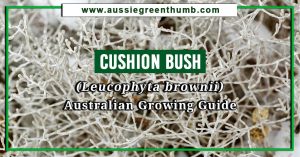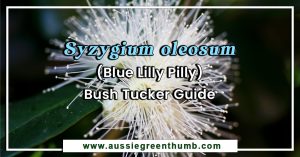There are two types of macadamia trees with nuts worth eating, Macadamia tetraphylla and, our focus today, Macadamia integrifolia. The latter, also known as the smooth-shelled macadamia, produces outstandingly smooth, creamy, nuts, with countless health benefits.
These edible seeds are amongst nature’s most revered products. However, the tree itself is a bit of a garden rarity, even here in its native land.
To find out more about these strikingly easy-going trees that can grow throughout Australia, keep reading. We’ve made everything from sowing and growing, to harvesting and feeding these trees as simple and as clear as possible.
More...
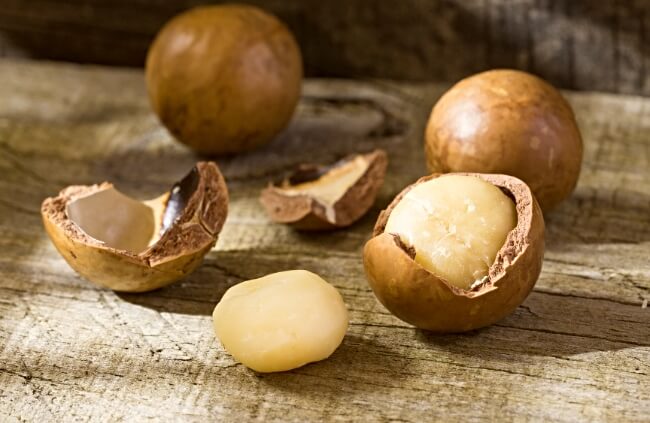
Family: | Proteaceae |
|---|---|
Genus: | Macadamia |
Species: | M. integrifolia |
Origin: | Australia |
Common names: | Smooth-shelled macadamia, Queensland nut, bush nut, Bauple nut and nut oak |
Location: | Outdoor |
Type: | Tree |
Growth: | 15m tall |
Sun requirements: | Full sun or dappled shade |
Foliage colour: | Green |
Flower colour: | Long cream-green racemes |
Flowering: | Early spring |
Edible parts: | Edible nuts |
Maintenance level: | Low |
Poisonous for pets: | Nuts are toxic to cats and dogs |
What is Macadamia integrifolia?
Throughout Queensland, usually around March, there are racemes of ripe green seed pods, dangling in clusters from a dense canopy of evergreen foliage. Each seed pod contains a single seed; a swollen macadamia nut. And each seed is a symbol of luxury.
They don’t store well, due to the fatty nature of macadamia nuts, so they need to be stored, dried, or cooked into a paste and frozen. But that makes them even more exciting.
Traditionally, these trees have been grown in Queensland and northern parts of New South Wales, but they have now been introduced to Sydney where they grow and fruit well, and are now cultivated extensively in Mexico.
The tree itself is nothing to write home about. Macadamia trees are fairly simple-looking plants with round canopies or large, rounded, evergreen leaves, which have little seasonal interest, and quite dull dangling poker flowers. But they aren’t grown for ornamental appeal, they are grown for their fruit!
Natural Habitat of Smooth-Shelled Macadamia
Macadamia integrifolia is native to mountainous rainforests, where it does best at the edge of forests with higher light levels. In mixed native forests, it provides a midstory canopy, so can be outcompeted by taller trees.
In gardens, it prefers open spaces, and should only be planted under dappled shade in warmer parts of the country if you are hoping for fruit.
While macadamias are found growing throughout New South Wales, they are not native to the area and have spread through human intervention. Thankfully, they do not seem to pose a threat to native species, and at just 15m tall, are unlikely to outcompete other native trees.
Due to the nature of nuts, their seeds are spread far and wide through native habitats, with some germinating and producing trees on scree slopes and open plains of Queensland. They are spread by animals, and germinate anywhere there is heat, moisture and slightly acidic soil.
Their preference, and most successful condition, producing the strongest naturally occurring trees, is on the rich, loamy edges of sloped forests, where they catch plenty of water runoff, but benefit from higher light, and excellent drainage.
Common Uses for Macadamia integrifolia
Macadamia integrifolia trees themselves have a single use, and that is for their produce. They are generally not used as ornamental trees, but macadamia nuts and their byproducts have countless uses.
Obviously, the nut itself is a great source of healthy fats, but the oil extracted from the nuts and husks has many cosmetic uses too.
The husks can be composted to make a fibrous potting soil, or burned as a sustainable renewable fuel. The fuel isn’t particularly efficient, but is often enough to reduce fossil fuel use in the processing of other macadamias in a circular system.
Identifying Macadamia integrifolia
Macadamia integrifolia is easily identifiable at all times of the year. Its large oblong leaves have a simple shape with vaguely waved edges. Each leaf is around 20cm long and 10cm wide, with a glossy green colouring on lower leaves, and a faint orange-red tip to new leaves.
The flowers are a creamy white, sometimes pink, raceme, with hundreds of small flowers drooping downwards. When pollinated, those racemes hold several green globe-shaped fruits, about 3-4cm across.
When ripe, the ground around Macadamia integrifolia will be covered in fallen green seeds, which can be split open to reveal hard, cream-coloured nuts.
How to Grow Macadamia integrifolia
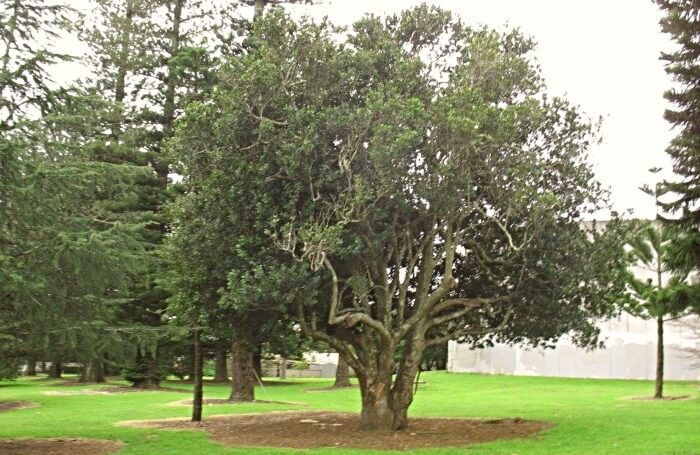
Source: Trust Trees Australia
Fertility, drainage, and plenty of water are the three keys to growing macadamia, which prefers rich loamy soils, with excellent drainage, and a rich mixture of minerals and nutrients to help develop the leaves which pack their seeds with the sugars that make macadamias so irresistible.
Providing these conditions in Australian gardens can be tricky in cities and suburbs, where garden soils can be poor, but depending on where you live, there are some simple ways to produce the perfect conditions for a delicious and reliable macadamia crop every year.
Ideal Conditions for Growing Macadamia integrifolia
At just 15m tall, and with a slow-growing root system, macadamia trees are great for small gardens, especially if you’re willing to train and prune them into productive forms.
After ten years, your macadamia tree should have developed its root system fully, so even if it is planted near a house, it will stop developing any unpredictable roots after that point, so it can be considered a relatively safe tree for built-up areas.
Soil & Drainage
Once you’ve found the right spot, consider their nutrient needs, and the sort of conditions these trees have in nature. Macadamias are adapted to rich, well-drained soils, so dig through plenty of organic matter.
For sandy soils, add as much organic matter as you can to help improve moisture retention and nutrient accessibility in the soil, mulching regularly each year thereafter.
For heavy clays, the same treatment is necessary and is more effective than gypsum soil additives, which help with nutrient accessibility but won’t improve the overall soil health in the same way as mulching.
Rotted horse manure is particularly useful for macadamia trees, and can be incorporated directly into the soil, or used as a mulch after planting.
Light & Temperature
Macadamias are warm-climate, tropical plants. They need full sun if you can give it to them, but will survive in partial shade. However, for optimal production, plant them somewhere warm and sheltered.
Shelter
Macadamias are not frost tolerant, and their ability to cope with wind is poor. To protect macadamias from frost in cold parts of the country, there are a few options.
Option one is to plant your macadamias in a large pot, which can be moved into a greenhouse each year. The second, which will help to provide more stable temperatures and reduce wind damage, is to plant and train your Macadamia integrifolia as an espalier.
By planting macadamias against a wall, and training them into neat frames on wires, not only do they become easier to manage and harvest, but they benefit from heat retention in the wall, are easy to fleece in winter if needed, and are rarely impacted by winds. Ideal for growers in colder southern areas.
Planting Smooth-Shelled Macadamia
Planting any tree requires careful forward planning, but macadamias are particularly picky about where they are planted and will respond very differently if they have any competition.
Weeds, of any kind, harm the success rates of macadamias without exception. When planting a new M. integrifolia, weed the entire area thoroughly, and mulch well after planting.
Plant just as you would with any other tree, by digging a hole as deep as the root ball, and twice as wide. Then plant it back with any organic matter mixed through the soil. After heeling the tree into its new home, water it well and add a stake against the prevailing wind if needs be.
Mulch heavily with organic matter like compost or well-rotted manure. Keep on top of the mulch as the tree develops, making sure to routinely remove weeds to prevent competition.
How to Propagate Macadamia integrifolia
Macadamias are difficult to propagate from cuttings, and growing them from seeds produces varying results. Macadamia integrifolia is the most frustrating example of this.
Essentially, because they will readily cross-pollinate with other native Macadamia species, they will not definitely, reliably produce edible nuts. The trees themselves can look identical to their parent tree but will take up to ten years to produce any nuts, which can be inedible when they finally arrive.
So, while cuttings are difficult, they are the more reliable long-term method of propagation. More reliable still is grafting, which produces reliable, true-to-type macadamia trees that will always produce fruit, and can often do so within just five years.
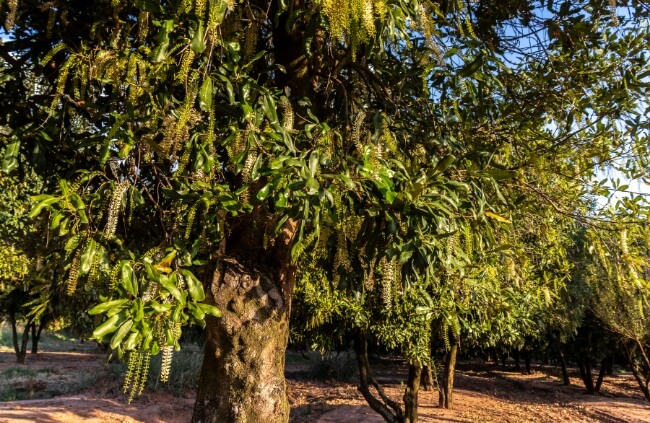
Propagating from Seeds
Macadamia seeds are best sown as soon as they are ripe, and at the latest, straight after they have fallen from the tree. However, it is entirely possible to germinate store-bought macadamia nuts, with or without their shell.
- Fresh seeds can be germinated without any soaking, while store bought nuts will need to be soaked in water for 48-72 hours before planting.
- After soaking, place the seeds onto a tray of compost or topsoil that can be kept at a temperature of around 25°C (this can even be done in a nursery bed outdoors if they are protected from pests).
- Germination is fast, usually in a day or two, and the plants will develop quickly from there.
- If sown in trays of compost, or individual containers, prick out into larger pots when they are large enough to handle.
Propagating Macadamia integrifolia from Cuttings
Macadamia will grow from cuttings, but it is not easy. If you do try this method, use a well-drained potting mix (garden compost mixed with perlite is ideal) and take softwood cuttings in late spring.
- Fill a 10cm pot with a loosely drained mix of compost and perlite.
- Cut a 10-15cm section of young growth from your macadamia tree.
- Dip into rooting hormone and insert into the pot, against the plastic wall to help with drainage.
- Water well, then cover with a plastic bag to hold in humidity.
- Place the whole thing somewhere bright and around 25°C, but out of direct sunlight until you spot signs of new growth.
Grafting Macadamia integrifolia
Use the same method to start your cutting, but instead of inserting it into the ground, you cut a slice into the stump of a 4 to 5-year-old macadamia tree, and insert the base of the cutting tightly into the cut.
Once the cutting is firmly inserted, tie twine or grafting tape tightly around the joint, and in a few weeks, you should see clear signs of new growth. This tree will produce seeds in as little as five years. Any nuts produced before then should be pinched off before they develop to focus your tree’s energy on growth.
Macadamias have traditionally proven difficult to propagate from cuttings, and while recent developments in the process have improved success rates, substantial variation in rooting ability between cultivars and species has been reported.
How to Care for Macadamia integrifolia
If planted in the right spot, on the right soil, mature macadamias aren’t needy. They will quite happily just get on with life without fuss. But, if you are planning on making the most of your harvests and encouraging them to bear more generous racemes of ripe nuts, then they’ll need a touch more attention.
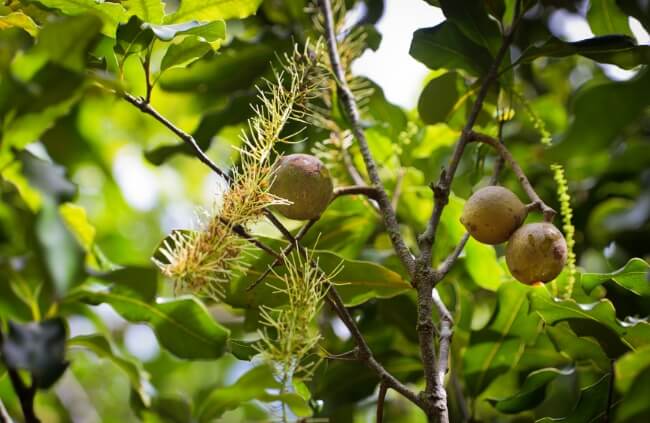
Watering Needs
The most important factor in caring for your smooth-shelled macadamias is water. They are drought-tolerant trees, but if you’ve had severe droughts one summer, the impact on the tree’s development for your next crop will be huge. And droughts in the current year are a sure sign of a poor harvest.
These trees grow in moist environments where water is abundant and reliable. Mimicking that at home can be costly, so it’s worth investing in a water butt to reduce your water usage if you can.
Water regularly through summer, and only when the ground dries out in winter.
Feeding Macadamia integrifolia
Every productive macadamia tree in home gardens likes to be fed, but you don’t have to be too prescriptive over what you feed it. They like general and varied minerals and even amounts of basic nutrients, so any balanced fertiliser or organic mulch will do the trick.
We use rotted horse manure here, but any rotted manure would do the job just as well. Perhaps even better would be rabbit or poultry manure, which is easier to apply and requires less bulky storage.
Simply apply a generous spindling or whatever dried manure you have, or an inch-thick layer of rotted manure once or twice a year.
It is also a good idea to keep and compost any husks you get from harvested nuts. The compost makes a brilliant soil conditioner and can open up the soil structure if it becomes compacted around the base of the tree.
Simply mulch with rotted macadamia husks and let the worms do the rest.
Pruning
Macadamia trees will form wonderfully elegant espaliers if pruned correctly, but if left to nature they can develop thick and heavy canopies that need drastic management.
Rather than pruning harshly all in one go, we advise pruning large branches bit by bit, over a couple of years. This will help to reduce the shock on the tree and mean you continue to get a crop each year while you work backwards to find the right shape again.
Pollinating Macadamia integrifolia
It is worth noting before we talk about harvesting, that macadamia are entirely reliant on insect pollination for a good crop. If they are shaken or wind-pollinated, there may be occasional nuts, but encouraging wildlife and pollinators into your garden is absolutely essential if you want a good crop of macadamia nuts.
But, let’s imagine we’ve been lucky, and our macadamias are utterly abundant. Then what?
Harvesting & Storing Macadamia Nuts
Macadamia integrifolia has a long harvest window that can spread out over six months of the year, from March to August. During that time, your tree can have nuts ripening at different times, or all at once, so check for the signs, and avoid just picking everything as soon as it swells to the right size.

Knowing When to Harvest Macadamia Nuts
Between March and August, the long harvest season of M. integrifolia, look out for nuts that are beginning to drop. They will drop one by one from their strung racemes, and when one falls, the rest of its cluster is usually ripe.
The husks and inner shells need harvesting as soon as they hit the ground as they will be quickly whisked away by rodents if you don’t beat them to it.
If you’re impatient, you can remove a nut from the tree, and drop it in water to soften the husk. A ripe macadamia nut husk has dark brown insides. If you peel away the husk and there is a white layer inside, the nut is not ripe.
How to Store Macadamia Nuts
Macadamia nuts are easy to store but do not last long in their whole form. As whole nuts, macadamias will keep for around three months in an airtight container in the fridge. When frozen whole, macadamia nuts are kept for six months.
The healthy oils in macadamias can spoil if the nuts are not stored properly. They keep for up to three months in an airtight container in the refrigerator. However, you may not know that they can also be frozen. Storing them in the freezer will keep them fresh for three to six months.
Common Macadamia integrifolia Problems
Macadamia integrifolia are especially receptive to two types of fungus – Neopestalotiopsis, and Pestalotiopsis. Both cause raceme blight and spoil crops more than any other disease.
Pests, as you might imagine on these rich nuts, are fairly common too. Below, we’ve gone through some of the most regularly occurring pests and diseases for Macadamia integrifolia, and how they affect the plant.
Macadamia integrifolia Pests
Stink bugs, spiders and dozens of species of nut borers are problematic pests for macadamia growers, whether you’re growing commercially or domestically.
The threat of infestation is greater in commercial macadamia plantations due to the monoculture providing a predator-free habitat for nut borers and stink bugs, but that doesn’t mean that those pests won’t impact your home-grown trees too.
One of the most common pests for macadamia nuts though, has to be the good old-fashioned rat.
Prevent nut borders on Macadamia integrifolia
Nut borers can’t be prevented on nut-producing trees, but you can manage the problem. Usually, nut borers take hold of just a few fruits, causing them to fall to the ground.
The caterpillars feed on developing nuts, having eaten holes through the hard shell. They then pupate and turn into moths, which lay more eggs on more developing nuts.
If you notice unripe nuts dropping from the tree, never leave them there. They often contain nut borers and should be disposed of.
Prevent rats around macadamia trees
The only reliable way to stop rats from eating your macadamias is by picking them up immediately, or harvesting them before they fall. As we mentioned previously though, harvesting macadamia nuts before they fall can be risky, as there is no way of testing their ripeness without breaking them open.
Managing other pests
Managing any pests around macadamia trees is difficult, because most pests are nut feeders, and hidden within the husk. Some pests like stem borders can be dealt with targeted insecticides and applications of neem oil, but for the most part, you will have to live with the pests and hope that natural predators come to the rescue.
Macadamia integrifolia Diseases
Disease of macadamia trees isn’t actually that common outside of commercial plantations, but if you notice any of the following, hopefully, we can help you get to grips with it before it causes a serious problem.
Anthracnose
Anthracnose can cause leaf spot and husk spot on macadamias, with brown spots, surrounded by dark black rings. The damaged fruits fail to ripen, and the damaged foliage can fall to the ground, where it rots down and repeats the cycle.
Prevent anthracnose from spreading or reoccurring by removing fallen leaves and husks. Mulch with alternative materials that are free from fungal or bacterial problems to boost the health of your macadamia the following year.
Husk spot (Pseudocercospora macadamiae)
Husk spot is the common name for the fungal pathogen, Pseudocercospora macadamiae, which causes pale orange patterns across green husks. This is caused by diseased or damaged old husks, which harbour the pathogen, sometimes for several years, having dried and not dropped from the plant, splashing rainwater on young husks.
Removing all old dry husks is an effective preventative, and any visible damaged young husks should also be removed.
Raceme blight (Botrytis cinerea)
Raceme blight is the blackening and withering of entire flowering racemes before husks develop. It can happen at any time and is usually at its peak in humid months, when flowers die back and naturally become hosts to passing fungal pathogens, like Botrytis.
The impact, if fallen racemes are collected and burned, is usually for a single year, but care should be paid to any recurrences, and any blighted racemes should be removed as soon as they are noticed.
Slow and quick tree decline (Kretzschmaria clavus / Xylaria arbuscula)
Kretzschmaria clavus is a root fungus that causes ‘slow tree decline’ in macadamia trees. It infects the root system and will slowly reduce the tree’s capacity to take up nutrients, causing patches of yellowing foliage, or leaf drop, which spreads to the whole tree.
It should be treated when it is spotted, and the tree removed to prevent spread to others.
Xylaria arbuscula is a similar pathogen, causing quick tree decline by infecting damaged parts of the trunk or branch, which very rapidly causes the browning of foliage and defoliation. It can be removed and burned if caught quickly.
Smooth-Shelled Macadamia FAQs
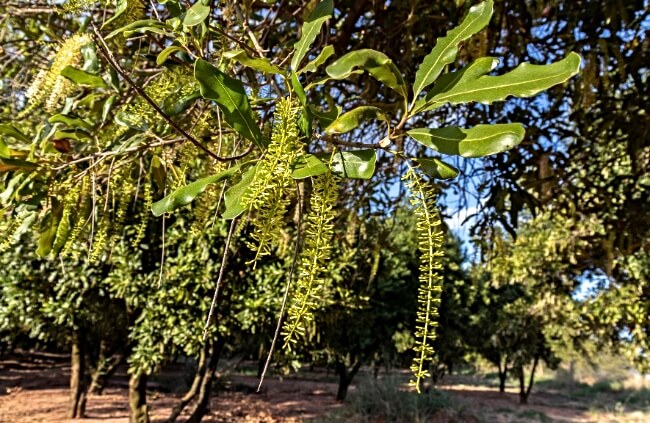
Who shouldn’t eat macadamia nuts?
Despite peanuts and other ground nuts falling into a distinct category, anyone with an allergy to peanuts or groundnuts should avoid tree nuts like macadamia nuts too.
What is the difference between Macadamia integrifolia and Macadamia tetraphylla?
Macadamia integrifolia and Macadamia tetraphylla are distinct species of tree within the same genus, but both are edible forms of macadamias. M. integrifolia is round with a smooth shell, often called smooth-shelled macadamia, while M. tetraphylla is (you guessed it) rough shelled, and commonly called the ‘rough-shelled macadamia’.
How big does Macadamia integrifolia get?
Macadamia trees grow to an ultimate mature height of 15m, but are usually closer to 10m after 10-15 years.
What does Macadamia integrifolia taste like?
Macadamia integrifolia is a sweet, creamy nut, with a smooth buttery flavour. Their high natural fat content makes them incredibly moreish, and very filling. They work well for sweet dishes just as well as savoury and make a creamy alternative to dairy milk.
Is Macadamia integrifolia a messy tree?
Macadamia integrifolia is an evergreen tree that holds its leaves well without a sudden drop like many deciduous trees. However, its tendency to drop flowers once pollinated does mean there is some mess to weep up on hard walkways.
Which is the best Macadamia variety?
Macadamia integrifolia and Macadamia tetraphylla both have excellent characteristics. There are some cultivars developed for overseas growers, but nothing works as well in Australian gardens as either of the two plain species varieties.
Can you eat macadamia nuts straight from the tree?
Macadamia nuts can be eaten straight from the tree when they are ripe. While some stores sell roasted, salted or prepared macadamia nuts, nothing quite tastes as luxurious as a simple, raw macadamia nut.
Is Macadamia integrifolia hardy?
Macadamia integrifolia is not reliably frost-hardy and should be protected from snow or temperatures below 5°C.
What is the best spacing for Macadamia integrifolia?
The best spacing for Macadamia integrifolia is 8-10m apart. Each tree will develop an upright canopy about 5-6m wide when mature, and a maximum height of 15m. They don’t like competition from other trees or each other.
Does Macadamia integrifolia have invasive roots?
Macadamia integrifolia roots are not invasive or damaging. They are shallow-rooted trees that spread outwards and take most of their water and nutrients from fine fibrous root systems spreading from the tap root (which is rarely deeper than 1.5m).
Enrich Your Garden with the Bountiful Harvest of Macadamia integrifolia
Macadamia nuts are exciting to harvest and easy to grow. The trees themselves might not be the most exciting ornamental addition to a garden, but they sure are worth it.
Hopefully, you’ve got a better idea of how, and where, to grow Macadamia integrifolia, and if you’ve come here looking for answers to specific issues, hopefully, we’ve been able to share some tips on looking after and caring for Macadamia integrifolia too.
Published on February 3, 2024 by Gary Clarke
Last Updated on March 4, 2024

